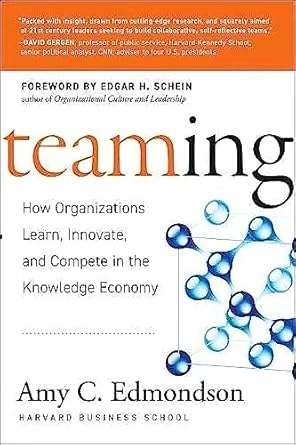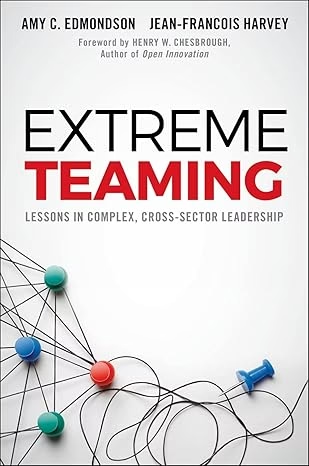“Psychological safety — the belief that one can speak up without risk of punishment or humiliation.”
—Amy C. Edmondson, Mark Mortensen.1
Amy C. Edmondson is the Novartis Professor of Leadership and Management at Harvard Business School. She specializes in leadership, teaming, and organizational learning. Edmondson has authored and co-authored several influential books, including “The Fearless Organization” and “Right Kind of Wrong.” Her research focuses on psychological safety, teaming, organizational learning, and a constructive approach to failure.
Psychological Safety
The concept of psychological safety is a workplace environment where individuals feel safe to take interpersonal risks. It is promoting the idea that organizations thrive in environments where employees can express themselves without fear of negative consequences.
Edmondson’s research demonstrates that psychological safety is vital for team effectiveness and innovation, particularly in uncertain or rapidly changing environments. It encourages open communication and reduces fear, enabling individuals to contribute fully.
Leaders can build psychological safety by modeling openness and constructive response to errors. It’s important to foster an inclusive environment where all voices are valued.

The Fearless Organization by Amy C. Edmondson
- Psychological safety is essential for high performance. Innovation and success need an safe environment. Employees should not afraid to share ideas, voice concerns, and admit mistakes.
- A structured approach fosters openness and accountability. Organizations must create intentional frameworks that encourage learning and engagement. These frameworks should also support constructive dissent while maintaining clear goals and accountability.
Amy Edmondson emphasizes that psychological safety is a fundamental driver of success in the modern knowledge economy. Businesses thrive when employees feel safe to express thoughts, ask questions, and challenge norms without fear of humiliation or punishment. A workplace culture that suppresses open dialogue stifles innovation and creativity, ultimately hindering long-term growth.
Edmondson argues that leaders need to actively cultivate an environment. where constructive disagreement and intellectual risk-taking are welcomed. These practices lead to breakthrough ideas and better decision-making.
Edmondson, Amy C. The Fearless Organization: Creating Psychological Safety in the Workplace for Learning, Innovation, and Growth. John Wiley & Sons, 2018.
Teaming
Teaming is the process of dynamic, fluid collaboration among individuals when they come together to tackle complex challenges. This often occurs across organizational boundaries. Unlike traditional, stable teams, teaming adapts to shifting needs and contexts.
In today’s fast-paced world, teaming is essential for innovation and problem-solving. Edmondson highlights that effective teaming depends on leadership that creates conditions like psychological safety and clear communication.
Organizations can support teaming by facilitating cross-functional collaboration, leveraging diverse expertise, and designing flexible structures that enable quick adaptation.

Teaming: How Organizations Learn, Innovate, and Compete in the Knowledge Economy by Amy C. Edmondson
- Organizational learning depends on dynamic collaboration. Success is no longer about static teams but about leading adaptable, learning-driven collaborations across an organization.
- Psychological barriers hinder learning and innovation. Fear, groupthink, power imbalances, and information hoarding prevent teams from effectively sharing ideas and growing.
In Teaming, Amy Edmondson explores how organizations learn and adapt in fast-changing environments. She argues that traditional static teams are no longer sufficient for driving innovation. Instead, businesses must focus on teaming—fluid, dynamic collaborations that continuously learn and evolve.
However, such learning doesn’t happen automatically. Factors like fear of failure, rigid hierarchies, and poor communication prevent effective knowledge-sharing. Edmondson highlights that psychological safety is crucial in overcoming these challenges. It enables individuals to reflect and share insights, so they can take risks without fear of negative consequences.
Edmondson, Amy C. Teaming: How Organizations Learn, Innovate, and Compete in the Knowledge Economy. John Wiley & Sons, 2012.

Building the Future: Big Teaming for Audacious Innovation by Amy C. Edmondson and Susan Salter Reynolds
- Large-scale innovation requires cross-industry collaboration. Bold ventures demand “big teaming,” where professionals from different fields must work together despite conflicting mindsets.
- Leadership must balance vision with adaptability. Success in large-scale projects depends on balancing ambitious goals with pragmatic, incremental progress.
In Building the Future, Amy Edmondson and Susan Salter Reynolds explore the leadership and collaboration required for audacious, large-scale innovation. The book follows the story of Living PlanIT, a start-up with an ambitious goal. They want to build a smart city from scratch as a testbed for high-tech urban innovation.
Achieving this vision required extensive collaboration between diverse stakeholders. They include software developers, real estate professionals, government officials, architects, and construction firms. These groups had vastly different norms, values, and working styles, creating significant challenges in communication, decision-making, and execution.
Edmondson, Amy C., and Susan Salter Reynolds. Building the Future: Big Teaming for Audacious Innovation. Berret Kohlers Publishers, Inc, 2016, https://amzn.to/43oqtPe.

Extreme Teaming by Amy C. Edmondson and Jean-François Harvey
- Modern collaboration extends beyond internal teams. Success increasingly depends on teaming across industries, organizations, and professions rather than strengthening in-house teams.
- Cross-boundary collaboration requires new leadership approaches. Managing large-scale, multi-disciplinary projects demands flexibility, communication, and strategies to overcome professional and organizational divides.
In Extreme Teaming, Amy Edmondson and Jean-François Harvey explore the growing need for global collaboration across industries, professions, and organizations. They argue that modern teamwork is no longer about building strong internal teams. It is about forming dynamic collaborations that bridge professional divides.
With cross-industry projects becoming more common, leaders must develop new strategies. The goal is to manage the complexity of working across shifting boundaries, differing expertise, and organizational cultures.
Edmondson, Amy C., and Jean-François Harvey. Extreme Teaming: Lessons in Complex, Cross-Sector Leadership. Emerald Publishing Limited, 2017.
Failure and Learning
Edmondson categorizes failures into three types, but only one—intelligent failure—is beneficial:
- Basic Failure. Simple, preventable mistakes in familiar situations, like a clerical error leading to a multimillion-dollar financial loss.
- Complex Failure. Failures caused by multiple interdependent factors, such as supply chain disruptions during a pandemic.
- Intelligent Failure. Failures that occur in new territory, are hypothesis-driven, goal-oriented, and small enough to provide insights without wasting resources.2
“It doesn’t matter if you fail. It matters how you fail.”
—Amy C. Edmondson.
The Value of Intelligent Failure
Edmondson argues that intelligent failure is the foundation of innovation and discovery. Scientists, for example, embrace failure as part of their experimental process. Organizations and individuals should adopt this mindset, treating failures as learning opportunities rather than personal shortcomings.
How to Foster Intelligent Failure
To encourage intelligent failure, individuals and teams should:
- Clearly define their goals and the progress they seek.
- Find knowledge gaps that need to be addressed.
- Formulate hypotheses and test them in controlled, low-risk environments.
- Learn from failures without fear of judgment or punishment.
Overcoming the Fear of Failure
Many people overestimate the stakes of failure, allowing fear to limit their willingness to take risks. Edmondson highlights that most failures are not catastrophic but rather opportunities to gain new knowledge. She encourages reframing setbacks as part of the learning process rather than personal defeat.
Lessons Learned and Best Practices for Product and Revenue Teams
For product and revenue teams, where risk-taking, innovation, and rapid iteration are crucial, Edmondson’s ideas have profound implications. These teams thrive when psychological safety is embedded into their culture and when they can take risks without fear. It drives innovation, growth, and resilience—whether launching new products, refining go-to-market strategies, or responding to customer needs.
Failure is not the opposite of success—it is an essential part of it. Organizations and individuals who embrace intelligent failure are more likely to unlock new opportunities. They should experiment thoughtfully and foster a culture of psychological safety. Doing so will lead to growth, innovation, and lasting achievement.
| Lessons Learned | Best Practices | Description |
|---|---|---|
| Encourage Open Communication | Implement Regular Feedback Sessions | Teams must test bold ideas and discuss failures without fear. Schedule consistent team meetings to discuss progress, challenges, and ideas openly. |
| Adopt an Open-Door Policy | Leaders should be accessible, inviting spontaneous discussions and feedback. | |
| Support Cross-Functional Collaboration and Adaptive Thinking | Use Agile ceremonies to align product, marketing, and sales teams on risks, failures, and customer feedback on a regular basis. | |
| Normalize Mistakes as Learning Opportunities | Conduct Post-Mortem Analyses | After project completion, review what went wrong and right to extract lessons. |
| Share Personal Failures | Leaders sharing their own mistakes can humanize them and encourage team members to be open. | |
| Foster Inclusivity in Discussions | Rotate Meeting Leadership | Allow different team members to lead meetings, ensuring diverse perspectives. |
| Use Anonymous Input Tools | Implement tools that allow team members to provide suggestions or concerns without attribution. |
Conclusion: Embracing Failure for Growth and Innovation
Amy Edmondson’s research highlights a crucial shift in mindset: failure is not the enemy of success but a stepping stone toward it. Product and revenue teams that embrace intelligent failure and foster psychological safety create environments where learning, innovation, and performance thrive. By encouraging open communication, supporting risk-taking, and ensuring that failures lead to valuable insights, organizations position themselves for long-term success.
How does your team handle failure? Do you have structures in place to encourage intelligent risk-taking and psychological safety? Share your thoughts and best practices in the comments below
For more insights subscribe to our newsletter and stay ahead with the latest research and expert perspectives.
- Edmondson, Amy C., Mortensen, Mark. “What Psychological Safety Looks Like in a Hybrid Workplace”. Harvard Business Review, April 19, 2021, https://hbr.org/2021/04/what-psychological-safety-looks-like-in-a-hybrid-workplace. ↩︎
- Edmondson, Amy C. Right Kind of Wrong. Atria Books, 2023, https://amzn.to/41pvc0p. ↩︎





Leave a Reply